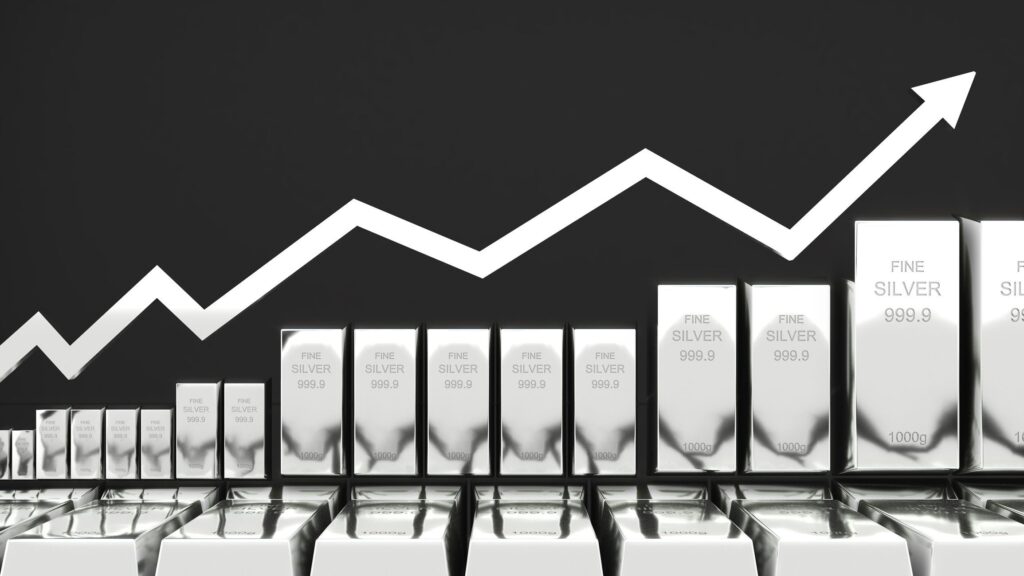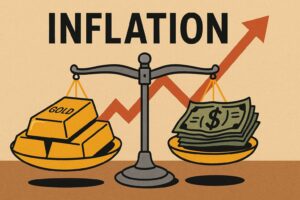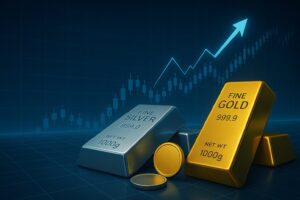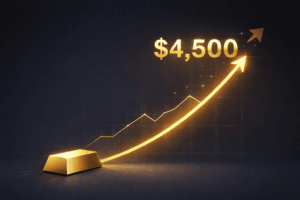
If you’ve been watching silver this year, you already know we’re witnessing something extraordinary. At $42 per ounce, silver has just reached heights not seen in over a decade, and with a stunning 45% gain year-to-date, it’s outpacing nearly every major asset class in 2025.
This silver price forecast suggests the rally is far from over. But here’s what makes this rally different from the ones we’ve seen before — and why Mike Maloney believes we’re still in the early stages of a much bigger move.
Silver Smashes Resistance: What It Means
When silver crossed $42 this week, it wasn’t just another milestone. It was a decisive break above 14-year resistance levels that technical analysts have been watching like hawks. This is further confirmation of many of the fundamentals we’ve been tracking at GoldSilver — and it’s finally showing up in the price.
While the S&P 500 has gained a respectable 12% this year, silver has nearly quadrupled that performance.
The Gold–Silver Ratio: What It Signals Now
Right now, the gold–silver ratio sits around 86:1 — down from over 100:1 earlier this year, but still historically high. That means silver is lagging gold, and history shows that when the ratio begins to compress, silver tends to surge.
Here’s what the math looks like if gold simply holds steady near $3,500/oz:
- 86:1 → Silver ≈ $40.7/oz
- 60:1 → Silver ≈ $58.3/oz
- 40:1 → Silver ≈ $87.5/oz
- 31:1 (last cycle’s extreme) → Silver ≈ $112.9/oz
These aren’t predictions — they’re scenarios. But they illustrate why so many seasoned investors, including Mike Maloney, view the Gold Silver ratio as a “hidden opportunity indicator.” When the ratio eventually normalizes, silver’s upside can dwarf gold’s percentage gains.
The Forces Powering Silver’s Surge
What’s driving this explosive move? It’s a perfect storm of factors that GoldSilver has been highlighting in his videos for months:
- Industrial Demand at Record Highs: The green energy transition isn’t slowing down. Solar panel installations are breaking records globally, and each panel requires approximately 20 grams of silver. Electric vehicles use up to twice as much silver as traditional cars. With governments worldwide committing trillions to renewable infrastructure, industrial silver demand has nowhere to go but up.
- The Silver Supply Squeeze: Here’s what mainstream financial media is missing: silver mine production has been flat for three years. Meanwhile, above-ground inventories continue to drain. The COMEX registered silver inventory has fallen by 35% since January, and London vaults are reporting similar drawdowns.
- Central Banks Can’t Stop Printing: Despite talk of fighting inflation, global money supply continues to expand. The Fed’s balance sheet may have shrunk slightly, but worldwide, central banks added $3.2 trillion in new currency this year alone. History shows us that when fiat currencies are debased, precious metals shine — and silver typically outperforms gold in these environments.
What Mike Thinks
Mike Maloney has long been an advocate for gold. But in recent years, he has said silver is his highest conviction trade. In recent videos he’s said:
That’s why it’s critically important to position yourself today—before the next major move higher.

Wait! Don't Forget Your Free Book
Mike Maloney's #1 all-time bestselling investment guide.
What This Means for Your Portfolio
Silver reaching $42 might sound a bit high. Some of you may think you’ve “missed the boat.” But in the context of where we believe this market is headed, it may look like a bargain in hindsight. Here’s what smart precious metals investors are doing right now:
- Dollar-Cost Averaging: Rather than trying to time the perfect entry, consistent accumulation smooths out volatility
- Physical Over Paper: In uncertain times, if you don’t hold it, you don’t own it
- Maintaining Perspective: Silver is volatile. Corrections of 10-15% are normal even in strong bull markets
The Risks Nobody Wants to Discuss
Yes, silver could pull back. A strengthening dollar, a surprise Fed pivot, or a resolution to geopolitical tensions could all create headwinds. But ask yourself this: which is more likely over the next five years — that governments will become fiscally responsible, or that they’ll continue printing money to fund deficits?
We think the answer is obvious.
Looking Ahead: Why $42 May Be Just the Beginning
If history is any guide, we’re entering the phase of the precious metals cycle where things get interesting. The public isn’t participating yet — Google searches for “buying silver” are still 70% below their 2011 peaks. When your neighbor starts asking about silver, that’s when you’ll know we’re approaching a top.
Until then, every pullback is an opportunity. Every moment of doubt is a chance to remember why you own precious metals in the first place: as insurance against monetary madness and a bet on the return to sound money.
How Investors Can Position Now
At GoldSilver, we’ve been preparing for this moment for years. If you’re new to precious metals, start with education — Mike Maloney’s Hidden Secrets of Money series remains the gold standard for understanding why precious metals matter.
If you’re ready to add to your position, remember that in bull markets, the best time to buy was yesterday, and the second-best time is today.
Your Silver Questions Answered
Why has silver rallied so strongly in 2025?
A combination of record industrial demand, flat mine supply, declining above-ground inventories, and ongoing central bank money creation have fueled silver’s rally.
What role does the gold–silver ratio play in silver investing?
The gold–silver ratio (GSR) is a key barometer for precious metals investors, measuring how many ounces of silver it takes to buy one ounce of gold. Historically, the ratio has averaged closer to 40–60:1 over the past century, but in 2025 it hovers near 86:1 — a level that suggests silver is deeply undervalued compared to gold.
Is silver mainly an industrial metal or a monetary metal?
Silver is unique because it’s both. Roughly half of annual demand comes from industrial uses like solar panels, electric vehicles, and electronics — sectors that are growing rapidly. The other half comes from investment demand, where silver acts as “poor man’s gold” and a hedge against inflation and monetary instability. This dual role makes silver more volatile than gold, but also gives it explosive upside during bull markets when both industrial users and investors are competing for limited supply.
How should investors approach silver at today’s price levels?
Strategies include dollar-cost averaging, focusing on physical silver over paper products, and maintaining perspective during normal market corrections.
What risks could impact the silver price forecast?
A stronger dollar, unexpected changes in Fed policy, or easing geopolitical tensions could weigh on silver. However, continued deficits and money printing remain the dominant long-term drivers.
Get Gold & Silver Insights Direct to Your Inbox
Join thousands of smart investors who receive expert analysis, market updates, and exclusive deals every week.









